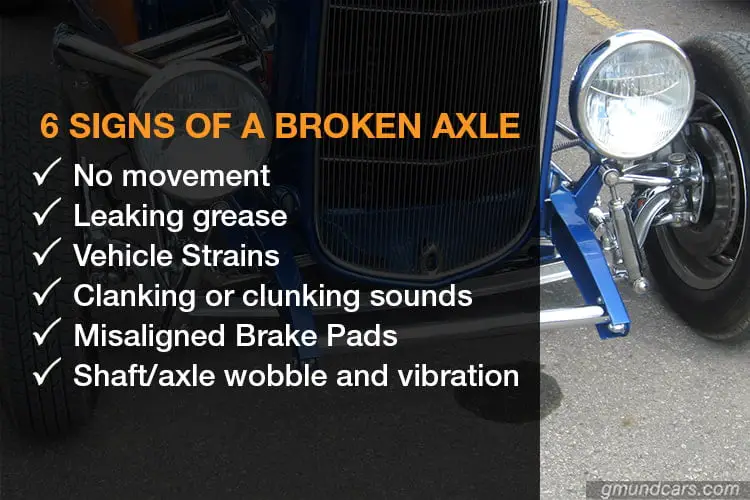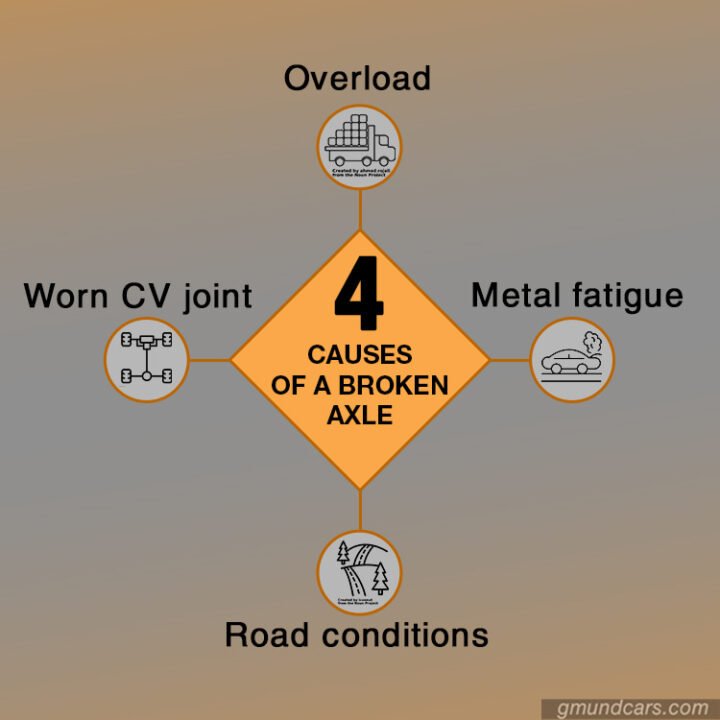The critical roles of axles include bearing the car’s weight and channeling power to the car’s wheel from the transmission. For a vehicle to have smooth and balanced motion, its axles must be in excellent shape. Intriguingly, even with a damaged axle, a car can continue to function, though observable symptoms will manifest.
However, when you have a wholly faulty axle, you won’t be able to move the car. If you discover that your wheels wobble when you drive, power loss at the wheels, leakages, or excessive vibrations from your vehicle, these could be signs that your axle(s) is faulty.

How Important Is Your Car Axle?
Think of it like this. A car axle is a connecting link between the wheels and components of steering and transmission. The axle allows the steering turning to translate to a corresponding turn of the wheels.
Essentially, the axle is a large steel bar/shaft through which power and torque are transferred to move and steer the wheels. The axles must be in good working order for a car’s functionality. Driving with a bad axle is highly dangerous. It’s likely to fail when you’re in motion and cause an accident or further compound repair costs.
Read more: Nissan Dashboard Symbols and Meanings: What All Drivers Need To Know
Signs Of A Broken Axle

Since broken axles typically don’t all of a sudden, looking out for some signs can help you prevent unexpected failure. The following are signs of a potentially damaged axle. It would be best to get your car inspected at a service center when you notice any or a couple of these signs.
No Movement
As the axles have the function of transferring power to the wheels, energy will not be transferred when the axle breaks.
All other essential components may function adequately. The engine, transmission, and other parts may show no sign of faultiness. Yet, when a car’s axle breaks, the wheels won’t turn when you step on the gas, and the car won’t move. At this point, you’ll need a tow truck to move your car from whatever spot it is.
Before the axle breaks absolutely, there would be telling signs that should alert you to whatever the problem is. Whenever you notice any potential sign of a damaged axle, you should immediately get it checked out at a service center. You surely wouldn’t like your car to break down in the middle of nowhere.
Leaking Grease
Leaking grease is one of the more visible signs of a faulty axle. When the CV boot (CV joint cover) breaks, the oil that lubricates the joint starts to leak, and if left unchecked, a leaking axle CV joint will continue to trap contaminants, corrode, and wear out fast.
If you discover grease on either side of the wheels or the tire edges getting covered in grease, that could be because of a deteriorating axle. A failure of the axle joint is inevitable when the joint cover continually leaks oil.
Vehicle Strains
As a car owner, you must pay attention to how your vehicle behaves at all times. When the axle is bent or damaged, you will experience some strain as you drive it. The gas pedal won’t feel as effective as it should be, and power transmission slows down.
You’ll notice that the vehicle takes more time to get going when you put it into gear. Like many of the other signs, there are different potential causes of vehicle strains. This is why it is essential to get the vehicle checked out as soon as you notice.
Clanking Or Clunking Sounds
Another likely sign of a broken axle is audible clunking or popping noise coming from the axle/wheel area. When you hear clanking sounds, the energy transferred from the axle to the wheel is insufficient.
That noise is usually made by the outer joint of the CV axle when starting to move or making turns the wheel.
Note that clunking noise could also signify something wrong with the transmission.
Misaligned Brake Pads
Once an axle is bent, you’ll almost immediately start to notice your wheels wobbling. A deflection when the brake pads begin to shift, as they become misaligned with the wheels and rotors.
You may not recognize the intensity of the misalignment as you drive, but it will be quite visible to people outside. If not fixed in time, the brake may stop functioning.
Shaft/Axle Wobble And Vibration
There are pretty many possible reasons for a wobbling/vibration axle. Nonetheless, a deteriorating axle is on that list. If your wheels start wobbling and you notice any other sign of a damaged axle, get your vehicle checked out. When there’s a fault with your axle(s), the wheels are bound to be unbalanced.
The wobbling and vibration in the wheels will become more pronounced as speed increases. A damaged axle could also cause you to experience intense vibrations every time you hit a bump or pothole.
Read more: Lexus Dashboard Lights: Everything You Should Know
What Causes A Broken Axle?

Overload
If your vehicle is relatively new and you experience a broken axle, overloading is one of the more likely causes. When you consistently overload your car with either passengers or cargo, it puts much stress on the axle. At a point, the axle will give way and break from the intensive load it has had to handle over time.
Metal Fatigue
It is not unnatural for axle metal to get weaker as a vehicle gets older. Also, cars that have been on the road for long and that carry weighty loads are more susceptible to metal fatigue. With time, the strength of the metal reduces, and it becomes more brittle.
Furthermore, the shaft metal could have been inadequately treated at the factory during manufacture. That would result in a brittle shaft that gives way quickly under little stress.
Worn CV Joint
A Constant Velocity (CV) joint connects the driveshaft to the transmission and wheels. As the CV joint transfers torque and endures consistent upward and downward forces of a car’s suspension, it experiences a lot of stress.
The CV joint is fitted with a boot cover to protect the joint from dirt and other contaminants. When the cover gets damaged, the lubricating grease leaks, and contaminants get in.
Over time, a lack of lubrication and constant contamination causes the CV joint to wear out. A worn CV joint will typically produce a popping noise when the vehicle is in motion. If not checked out in time, the axle will eventually break.
Road Conditions
Driving a car on bad roads will put much stress on the axle. When you hit road bumps and potholes more often, much force concentrates on the shaft, making it more likely to break. The axle shaft can break when you run into curbs, speed bumps, or other obstacles.
Additionally, the way you drive impacts your vehicle’s axle. Turning at great speeds and constant sudden braking puts pressure on the axle shaft. A fatigued shaft or worn joint will snap easily in these conditions.
Read more: Jeep Warning Lights and Their Meanings
What Happens If Your Axle Breaks While Driving?
If your axle shaft breaks while driving, your vehicle will stop moving. Power will cease to transfer from the engine and transmission to the wheels.
When you’re moving at high speed, and your axle breaks, you may struggle to control and get in an accident. The effect is instant!! Staying in control is much easier when an axle breaks entirely and you’re not speeding. What do you do if your axle breaks while driving? Call a tow truck.
On the other hand, if your axles are just failing, your vehicle should still be drivable. Also, if an axle begins to fail while driving, you may get the allowance to pull over before the wheel loses power completely.
Like we’ve discussed, knowing what warning signs to look for can help you prevent axle failure.
Can I Drive With A Broken Axle?
The severity of the axle damage determines if you can still drive a car or not after you experience a broken axle. Typically, axles don’t just break all of a sudden. There are telling signs that would point to the fact that the axle is deteriorating. If you, however, do not pay attention to these signs, the axle may break while you drive.
Nearly Broken Axle
Axle breakage is gradual, and when it starts to happen, one of the first things you’ll notice is your car pulling to one side. It’s because power is not properly transmitted to the wheel on that side.
A vehicle pulling to one side can likewise be a symptom of some other problems, but the most important thing is that you get it checked out by a qualified professional ASAP.
Your car can remain mobile with a nearly broken axle. Still, it is recommended that you have it repaired as soon as you notice any problem. Don’t take chances unless you want your wheel falling off and your car stopping all of a sudden in the middle of nowhere.
Broken Axle
A worn or damaged axle that’s not fixed will eventually snap. As a result, power transmission to the wheels will cease, and the car will stop moving.
In addition to the inconvenience you would experience, it is also potentially dangerous. Say you’re going at a breakneck speed when it breaks; it’s relatively easy to lose control and get in an accident.
Furthermore, when an axle breaks, it can fly off together with the wheel and its whole assembly. A fractured axle would require more repair than a worn or nearly broken axle. When your axle fails in motion, your car may suffer some body damage.
Conclusion
A broken axle is relatively rare, but it happens. Before it happens, however, there are numerous signs you, as a car owner, would notice. Wonder what the function of the axle is? Or what the symptoms of a broken axle are? We’ve discussed that in detail, together with some other essential things you should know about car axles.
Frequently Asked Questions (FAQs)
Can a broken axle damage transmission?
Yes, a broken axle can damage the transmission. When the CV joint wears out and breaks, the driveshaft may bend or fall out in the differential carrier. When the differential becomes movable in the transmission, you may need to replace the transmission. A broken axle can also lead to transmission leaks when the seals get damaged.
Is a broken axle repairable?
Replacing is the solution to a broken axle. Sure, specific axle components and cracks are repairable. However, that poses too much risk as it can quickly fail again when you’re driving. In cases where the CV joint boots break and the joint does not wear considerably, a simple boot replacement would suffice.
How much does an axle replacement cost?
Axle replacement costs anything between $500 and $650. At the same time, labor could cost as low as $50 or as high as $150. However, the cost of an axle replacement is significantly dependent on the type of vehicle, the brand, and the model. Have your vehicle checked out and the price of a replacement estimated at your local service center.
